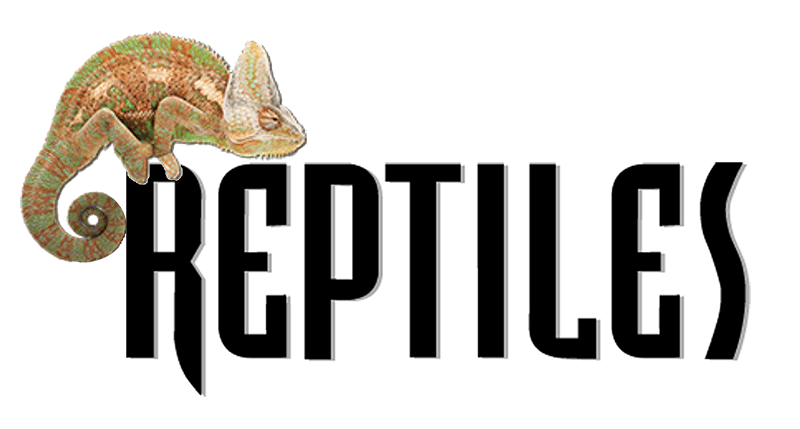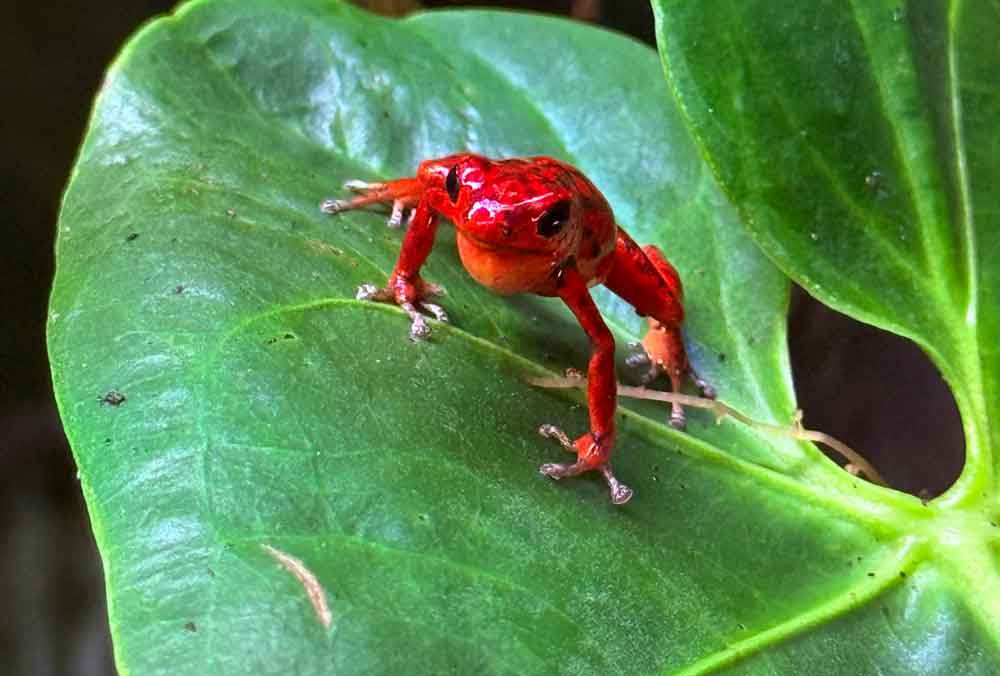Poison frogs thrive in stable, well-maintained environments, so regular care, cleaning and monitoring are key.
Poison frogs, or dart frogs, are vibrant, captivating amphibians that make excellent additions to a bioactive terrarium. For beginners, species like Dendrobates tinctorius, Dendrobates auratus, and Phyllobates terribilis are ideal, as they are hardy and are able to adapt well to captivity.
A proper setup is essential for their health. Start with a glass enclosure, 18x18x24 inches or larger. First you’ll need to create a bioactive terrarium with a false bottom for drainage (such as Lecca), a substrate mix (such as ABG mix), live plants, and lastly but very important, leaf litter.
Springtails and isopods are also known to be a must in the vivarium as they are the clean-up crew, maintaining a natural ecosystem. This means that the isopods will eat away at the frog fecal matter while the springtails will eat both the isopod waste matter, and any other decaying matter in the vivarium. It is important to maintain humidity levels between 80-100% with daily manual misting or an automated misting system which will be covered later in the article.
In order for your live tropical plants and moss to thrive, lighting should replicate a day-night cycle, using LED or UVB lights to support their growth and frogs’ natural rhythms. A temperature range of 70- to 80°F is optimal. Extreme heat and cold temperatures should be avoided as frogs are very sensitive to extreme temperatures.
Diet consists of small, live insects such as flightless fruit flies, pinhead crickets (baby crickets), and springtails, dusted with calcium and vitamin supplements. Feeding for adult dart frogs is between three to four times per week. Juvenile frogs should be fed daily if possible.
Poison frogs thrive in stable, well-maintained environments, so regular care, cleaning and monitoring are key. With proper husbandry, these fascinating frogs can live 10-15 years in captivity, bringing years of enjoyment.
Feeding Poison Frogs: A Detailed Routine
Feeding poison frogs properly is crucial to their health and longevity. Their diet consists entirely of small, live insects, which mimic their natural prey in the wild. The most common staple food for poison frogs is flightless fruit flies (Drosophila melanogaster and Drosophila hydei), which are readily available and easy to culture at home.
Each feeding session should include enough food to ensure every frog in the enclosure has a chance to eat, typically 20 to 50 fruit flies per frog depending on their size and appetite. Daily feedings are recommended to support their rapid growth. Sprinkle the insects with a high-quality calcium powder at every feeding to prevent deficiencies. Use a multivitamin supplement once or twice a week to provide essential nutrients and support their rapid growth, offering smaller prey like D. melanogaster.
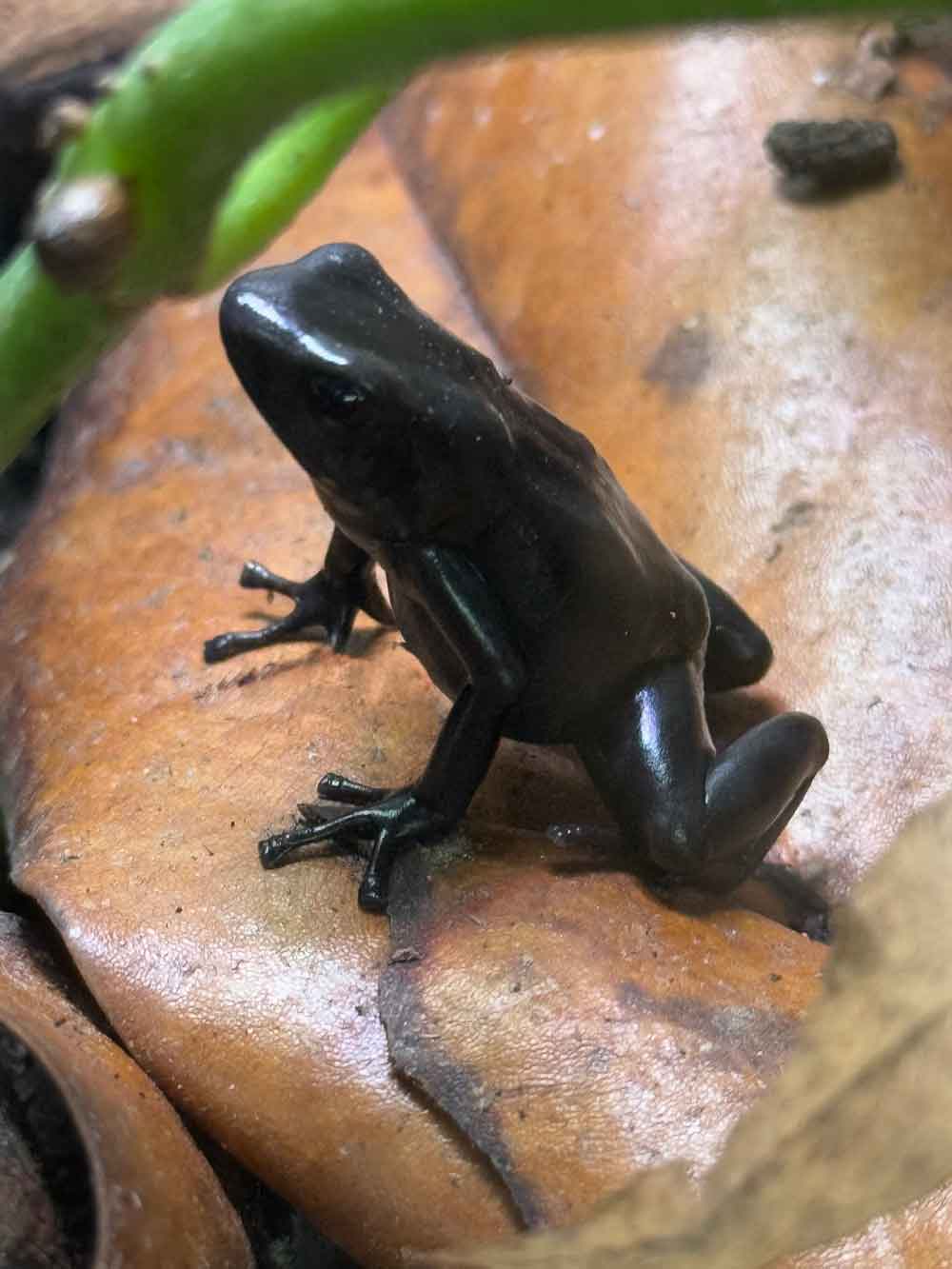
Dendrobates auratus Costa Rican Green and Black Melanistic. Photo by Carolina Arraujo
Supplementing their diet is essential to prevent deficiencies. Dust fruit flies with a high-quality calcium supplement at every feeding. Twice a week, include a multivitamin powder to provide additional nutrients like vitamin A, which is critical for their skin and eye health. Rotate supplements to avoid over-supplementation and ensure a balanced nutrient intake.
To feed, place the insects into the enclosure near the frogs’ resting areas. Frogs are visual hunters and rely on movement to identify prey, so ensure the insects are active. Monitor their feeding habits—leftover prey may indicate overfeeding or stress, while an eager appetite signals good health.
Other prey items, such as springtails and isopods, can be introduced into a bioactive enclosure to provide constant foraging opportunities. For variety, consider offering pinhead crickets or small bean beetles occasionally. Always ensure the prey size is small enough for the frogs to handle easily.
Monitoring your frogs’ body condition and activity levels will help you adjust feeding routines as needed. Proper nutrition ensures your poison frogs remain vibrant and healthy for years to come.
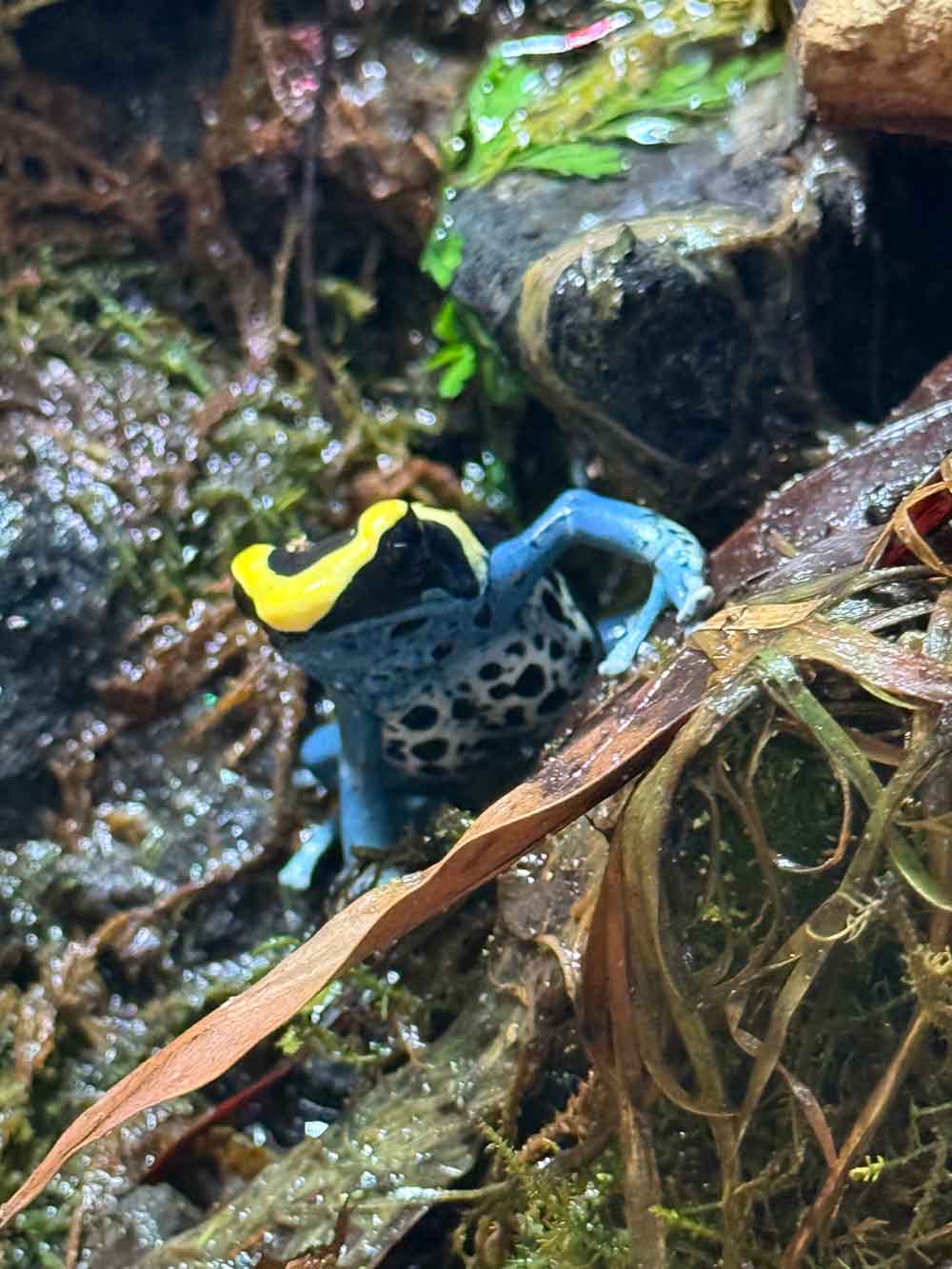
Dendrobates tinctorius Photo by Carolina Araujo
Creating the Ideal Poison Frog Enclosure: A Living Art Masterpiece
Designing an enclosure for poison frogs goes beyond providing them with a home—it’s an opportunity to create a living work of art that mimics their natural habitat. A well-crafted bioactive terrarium not only supports your frogs’ health but also becomes a captivating display of nature’s beauty. This is how I ended up falling in love with the dart frogs and building their vivariums.
Enclosure Size and Type:
A glass terrarium is ideal for maintaining the high humidity and visibility that poison frogs require. For a small group of frogs (two to three), an 18x18x18-inch terrarium is a good starting size, while larger groups may need an enclosure of 24x18x24 inches or bigger. Again, ventilation is key and most stock enclosures require some modifications to the coverings. My husband Charles Lueras has taught himself how to cut and drill holes in glass plus create custom screen tops with mesh to provide the required ventilation. Otherwise ordering custom tops from a third party vendor for 20 of the enclosures we now have would have been super expensive.
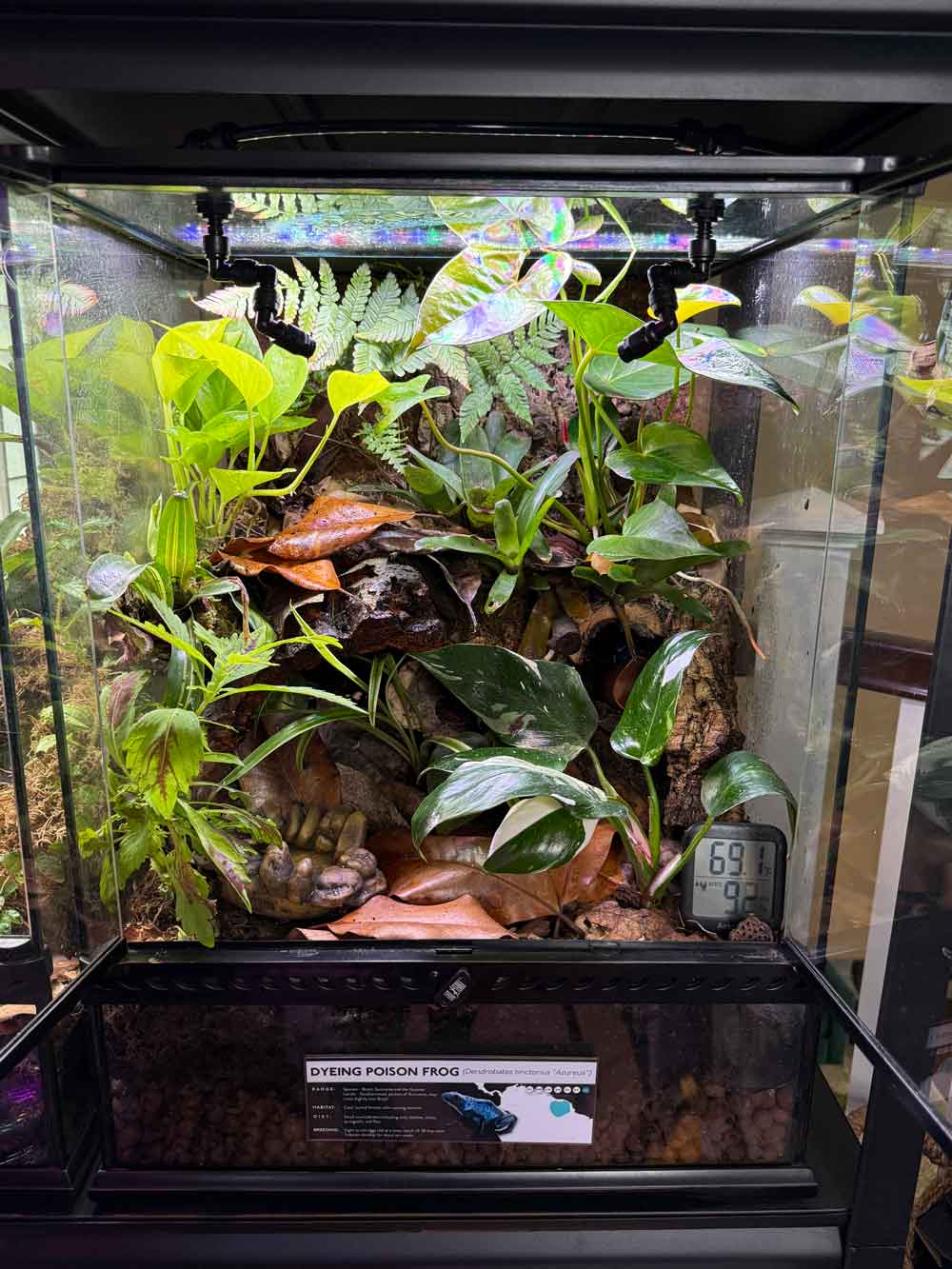
Photo by Esmie Lueras
Substrate and Bioactive Setup:
Creating the baseline is fundamental. Start with a false bottom layer using LECA (lightweight expanded clay aggregate) or gravel for drainage, topped with a mesh barrier to separate it from the substrate. Use an ABG (Atlanta Botanical Gardens) mix or a blend of coconut fiber, orchid bark, and sphagnum moss for planting. I now make my own using recipes from SerpaDesign found on YouTube. Add live plants such as bromeliads, ferns, creeping vines and moss to provide hiding spots and visual interest. A heavy layer of leaf litter is a must and helps retain moisture in the vivarium plus it offers the dart frogs places to forage.

Drilling the glass for the misting system. Photo by Esmie Lueras
Next, introduce springtails and isopods as a clean-up crew (CUC) to break down waste, reducing the need for frequent maintenance. These tiny organisms also serve as a supplemental food source for your frogs. However, regular cleaning of water and the enclosure itself is necessary to monitor for any problem areas that need attention.
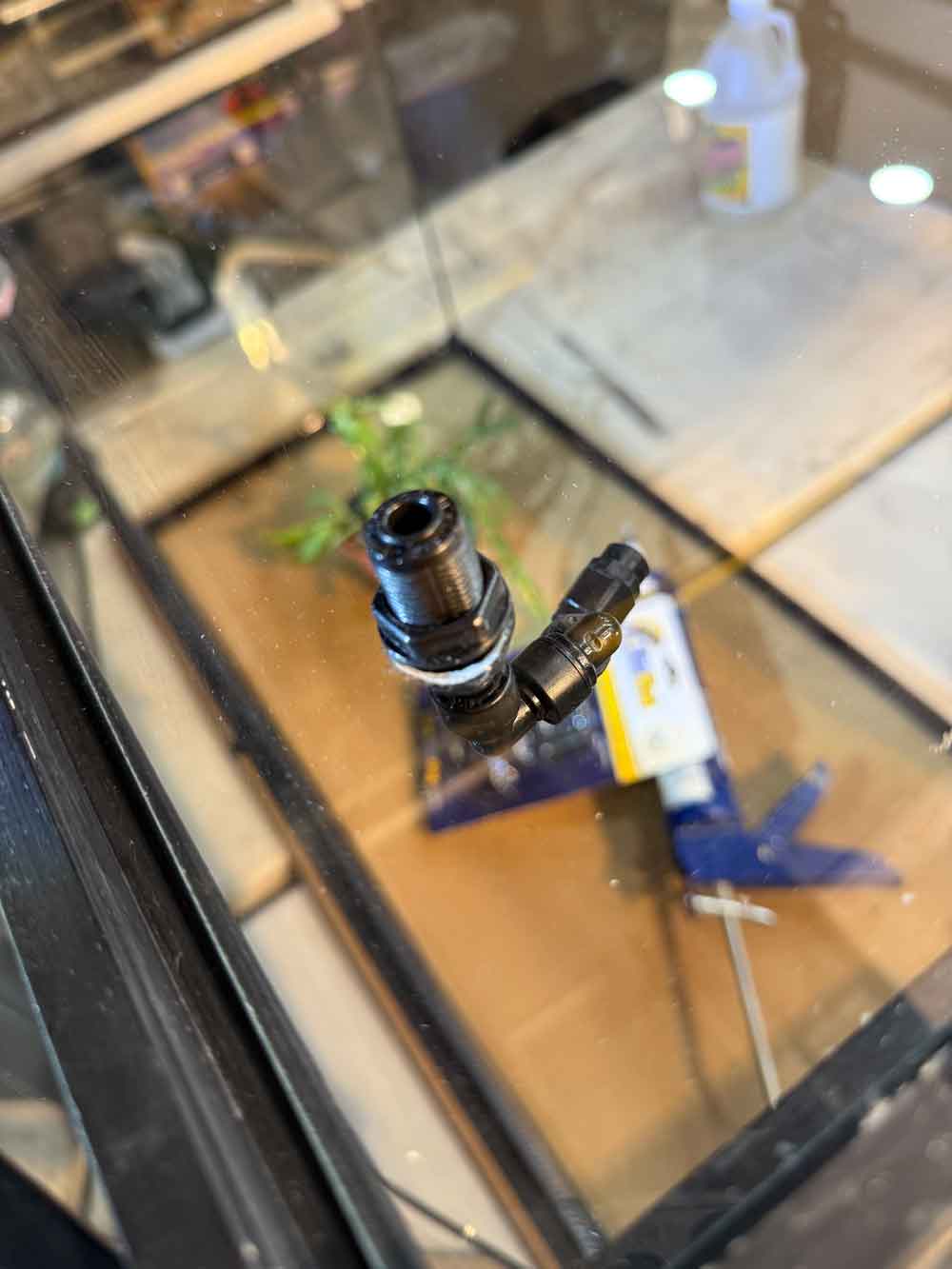
Attaching the misting system nozzle. Photo by Esmie Lueras
Humidity and Water Features:
Maintain humidity levels between 80-100% using a misting system or hand misting daily. A small water feature, like a shallow pool or dripping leaf, can enhance the aesthetic while providing frogs with hydration and environmental enrichment. Ensure water features are shallow and safe to prevent accidental drowning. For beginner’s in the hobby, it may be best to stay away from water features that require pumps and such things. The water feature is a beautiful addition but can go wrong very quickly. For example, the water pump may stop working and now you have to ensure that your vivarium doesn’t have contaminated water that may harm your frog.
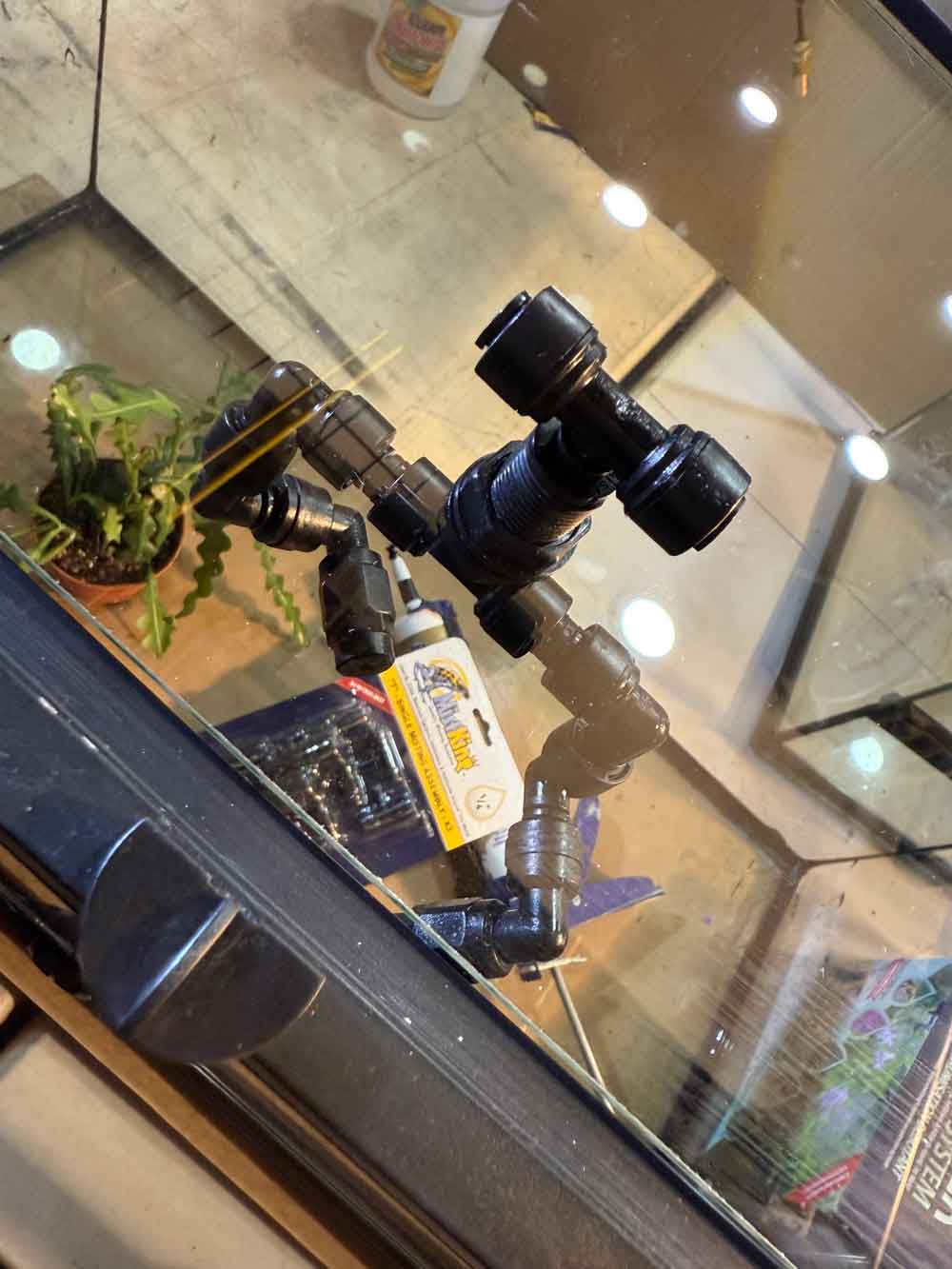
Lighting and Temperature:
Use LED lights to illuminate the plants and enhance the enclosure’s visual appeal. UVB lighting isn’t strictly necessary for poison frogs but can benefit plant growth and mimic natural light cycles. Maintain a temperature range of 70-80°F using a thermostat to prevent overheating.
Living Art:
With its lush greenery, vibrant frogs, and natural design, your poison frog terrarium becomes a living piece of art. Experiment with the layout, using cork bark, driftwood, and moss to create a visually stunning, functional habitat. Each terrarium becomes a unique ecosystem, blending beauty with purpose.
Not only does a bioactive terrarium provide an ideal environment for your frogs, but it also offers you a mesmerizing window into the rainforest, a true masterpiece of living art.
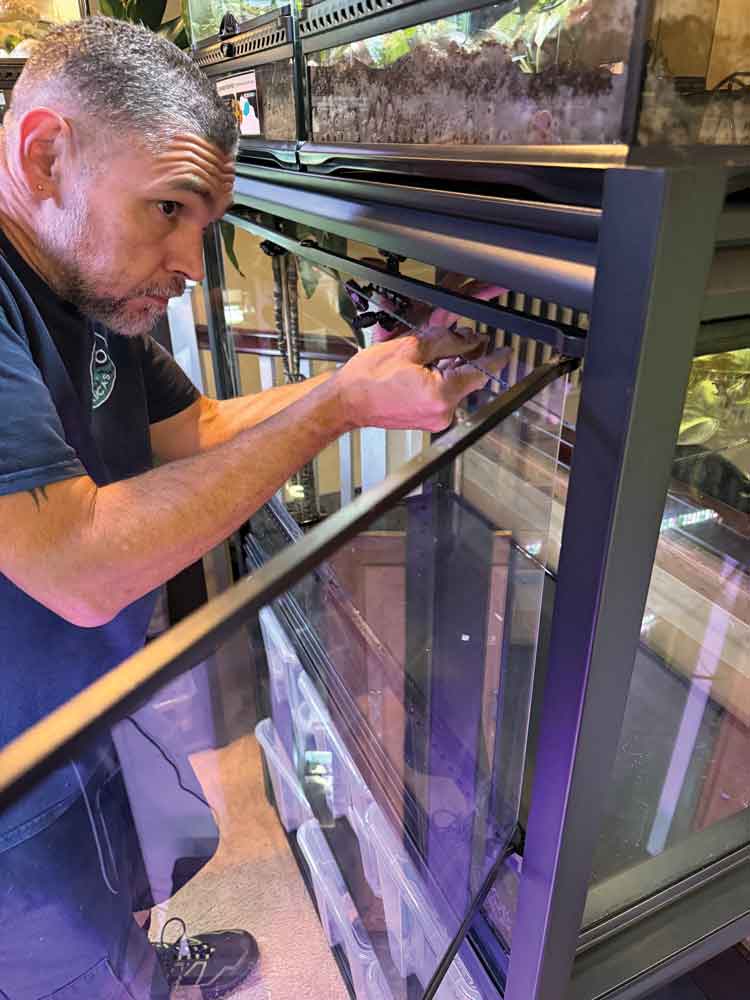
Finishing touches on the enclosure. Photo by Esmie Lueras
Choosing the Best Misting System and Creating a Misting Schedule for Poison Frogs
Maintaining high humidity is critical for the health and well-being of poison frogs, as they rely on a moist environment to keep their skin hydrated and functional. Investing in a reliable misting system can simplify care and ensure consistent conditions in your terrarium.
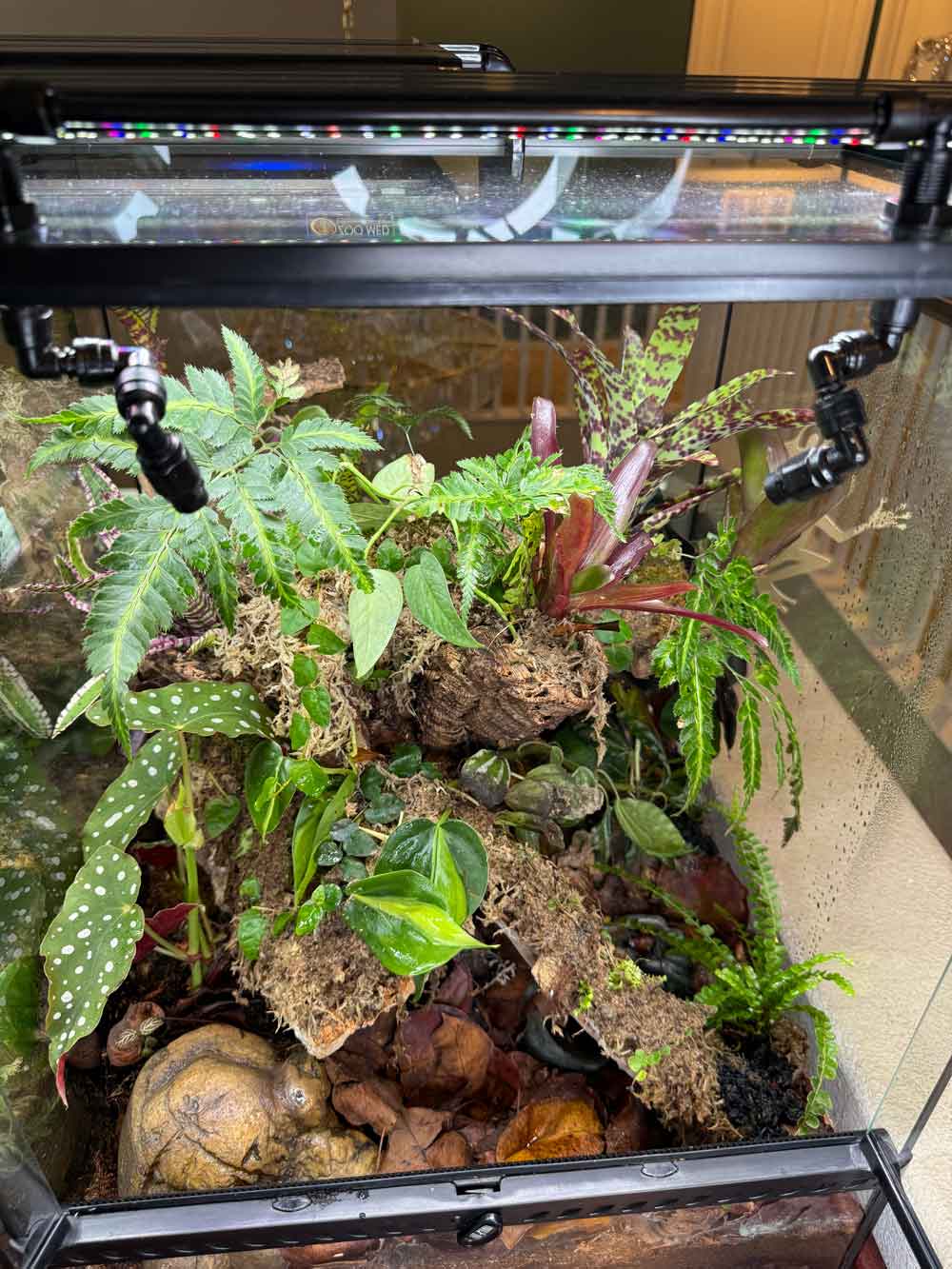
Adding plants. Photo by Esmie Lueras
The Best Misting Systems for Poison Frogs
When selecting a misting system, look for one that delivers fine, even misting, is programmable, and durable. Here are some top options:
1. MistKing Starter System
• A highly popular choice among amphibian keepers, MistKing provides precision misting with adjustable nozzles. It’s reliable, quiet, and expandable, making it ideal for beginners and advanced hobbyists alike.
2. Exo Terra Monsoon Multi
• A user-friendly, plug-and-play option. The Exo Terra Monsoon is great for smaller setups, offering programmable misting schedules and ease of use.
3. Zoo Med Repti Rain
• A budget-friendly alternative, this system is perfect for smaller enclosures or those looking for a more basic option.
When choosing a system, ensure it fits the size and needs of your terrarium. A single nozzle is sufficient for small tanks, while larger enclosures may require multiple nozzles for even coverage. This is the area where it becomes key to know how to build (or order) your custom enclosure tops and be able to adapt the mist nozzles required.
Misting Schedule for Poison Frogs
Poison frogs require consistent high humidity, ideally between 80-100%. It doesn’t have to be an exact science either but just try to keep the enclosure between from 70% to 90%. Your misting schedule should reflect this need, while also preventing oversaturation, which can lead to mold or substrate issues.
Recommended Misting Schedule:
1. Morning Mist (7:00 AM – 9:00 AM):
Begin the day with a 15-20 second misting session to simulate morning dew and raise humidity. This kickstarts the frogs’ activity cycle.
2. Midday Maintenance (12:00 PM – 2:00 PM):
A shorter misting session (10-15 seconds) helps maintain humidity levels during the hottest part of the day
3. Evening Mist (6:00 pm to 8:00pm)
End the day with a final mist which I’ve observed triggers hidden fruit flies to move around making them easier for the dart frogs to find and eat.
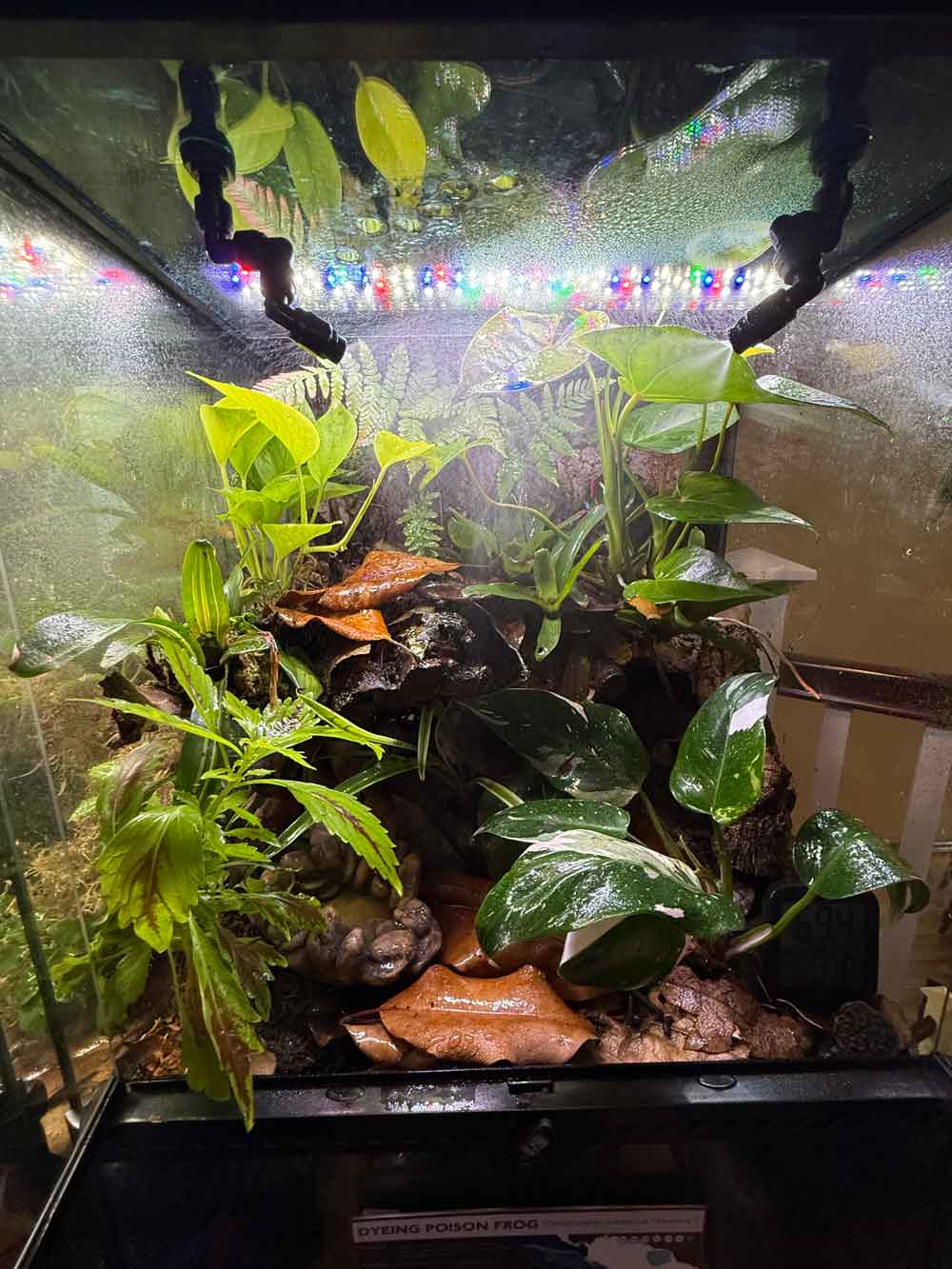
Ideal Plant Selection for Poison Frog Enclosures
The plants you choose for a poison frog terrarium play a crucial role in creating a lush, natural environment that mimics their tropical rainforest habitat. The right plants enhance the visual appeal but also provide essential hiding spots, climbing surfaces, and humidity regulation. Here are some categories of plants and top recommendations for a thriving bioactive enclosure.
Epiphytic Plants
Epiphytic plants grow on surfaces like wood or rocks, making them perfect for creating height and natural perches in the terrarium. These plants thrive in the high humidity levels that poison frogs require.
• Bromeliads (e.g., Neoregelia species):
Ideal for poison frog enclosures, bromeliads collect water in their central cups, providing microhabitats for frogs to sit and hydrate. Popular varieties include Neoregelia fireball and Neoregelia compacta.
• Tillandsia (Air Plants):
These require minimal substrate and can be mounted on cork bark or driftwood. Ensure they are misted regularly to stay hydrated.
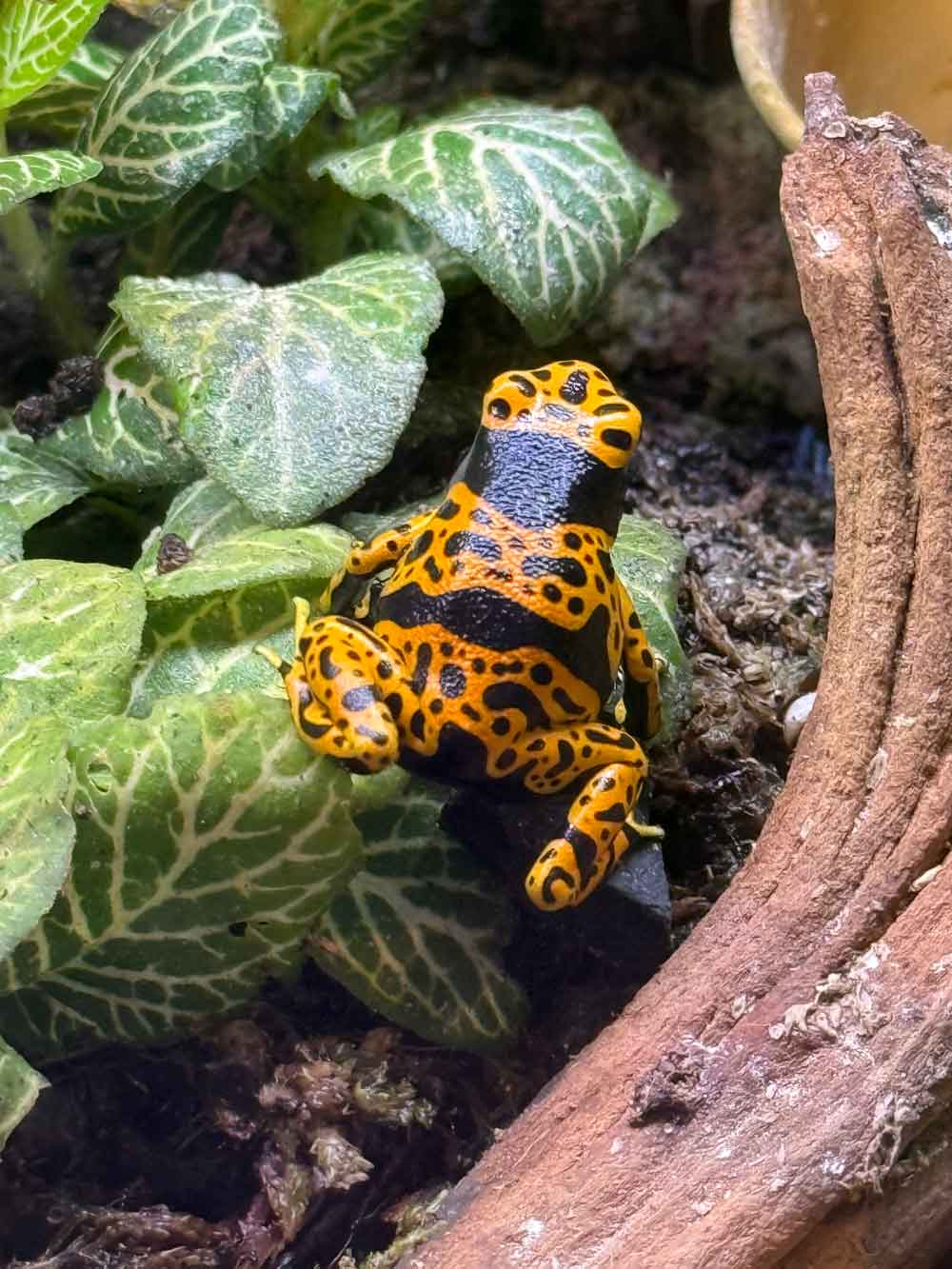
Fine spot Dendrobates leucomelas. Photo by Carolina Arraujo.
Ground Cover Plants
Ground cover plants spread along the substrate, creating a carpeted look and mimicking the dense forest floor.
• Moss (e.g., Christmas Moss, Java Moss, Pillow Moss):
Mosses are perfect for covering damp areas, aiding in humidity retention, and giving the enclosure a natural feel.
• Creeping Fig (Ficus pumila):
A fast-growing vine that works well as ground cover or climbing decor. It thrives in humid, warm environments. I love it!
• Peperomia species:
Compact and hardy, peperomias are low-growing plants with attractive foliage, ideal for shaded, humid areas.
Vining and Climbing Plants
Vining plants add vertical interest and provide climbing opportunities for frogs. They also create a layered, dense environment, offering hiding spots.
• Pothos (Epipremnum aureum):
A highly versatile and hardy plant, pothos thrives in low to moderate light and high humidity. Its fast growth makes it a favorite for covering backgrounds and hardscape.
• Philodendrons (e.g., Philodendron micans, Philodendron brasil):
These trailing plants offer vibrant foliage and thrive in humid, shaded enclosures.
• Monstera adansonii (Swiss Cheese Vine):
A smaller Monstera species with delicate, hole-filled leaves, perfect for terrariums.
Ornamental Foliage Plants
These plants add a pop of color and texture, turning your enclosure into a living work of art.
• Calathea (Prayer Plants):
Known for their striking patterned leaves, calatheas thrive in the moist, shaded conditions that poison frogs prefer.
• Fittonias (Nerve Plants):
With their vibrant, veined leaves, fittonias add bold color and texture to the terrarium. They’re low-growing and ideal for foreground planting.
• Begonias (e.g., Rex Begonias):
Begonias bring unique patterns and vibrant hues, though they may require slightly more care to thrive in high humidity.
Aquatic or Semi-Aquatic Plants
If your terrarium includes a water feature, aquatic plants can enhance the aesthetic and provide additional microhabitats.
• Anubias species:
Hardy aquatic plants that thrive in both water and moist substrate.
• Java Fern:
Perfect for shallow pools or humid areas near water features, this plant adds texture and thrives with minimal care.
The list goes on and on and once your vivarium is well established, the bonus is that you can self-serve with cuttings of your own enclosure for other new enclosures and projects.
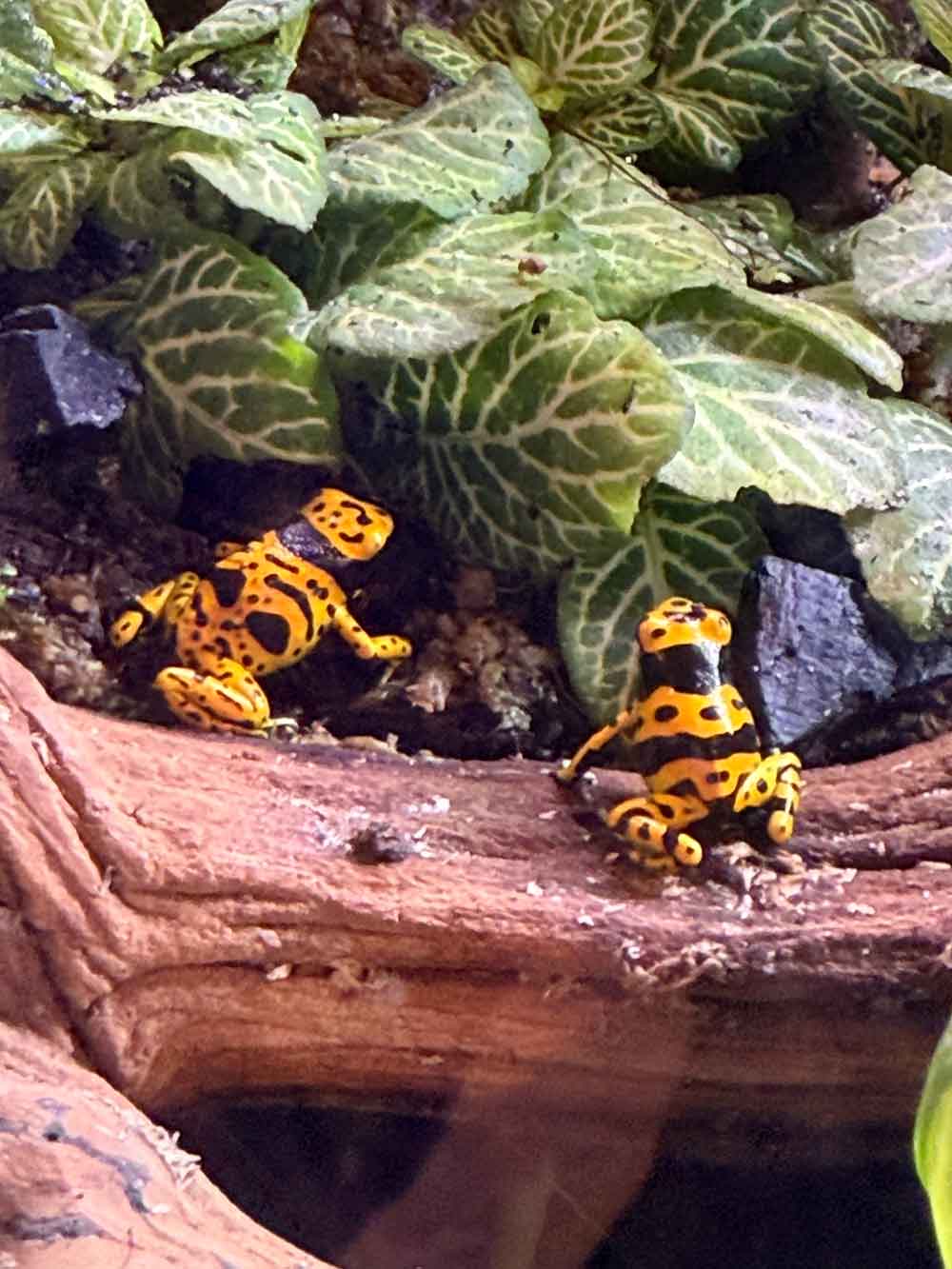
Fine spot Dendrobates leucomelas. Photo by Carolina Arraujo.
However, another area to keep in mind is that you’ll have to clean (or sanitize) any new plants that you are introducing to your vivarium when the source is unknown. This is to prevent any contamination, mold or creatures known in the hobby as “hitch-hikers” such as slugs or snails that may harm your plants and animals. It’s best to be preventative and eliminate the potential of any problems ahead of time.
Overview of Known Poison Frog Species
Once you have established your enclosure, the next step is to identify which dart frog you like and its availability. I have found that in some cases, dart frogs are highly popular and coveted that just because you want to own a dart frogs doesn’t mean you’ll find one readily available.
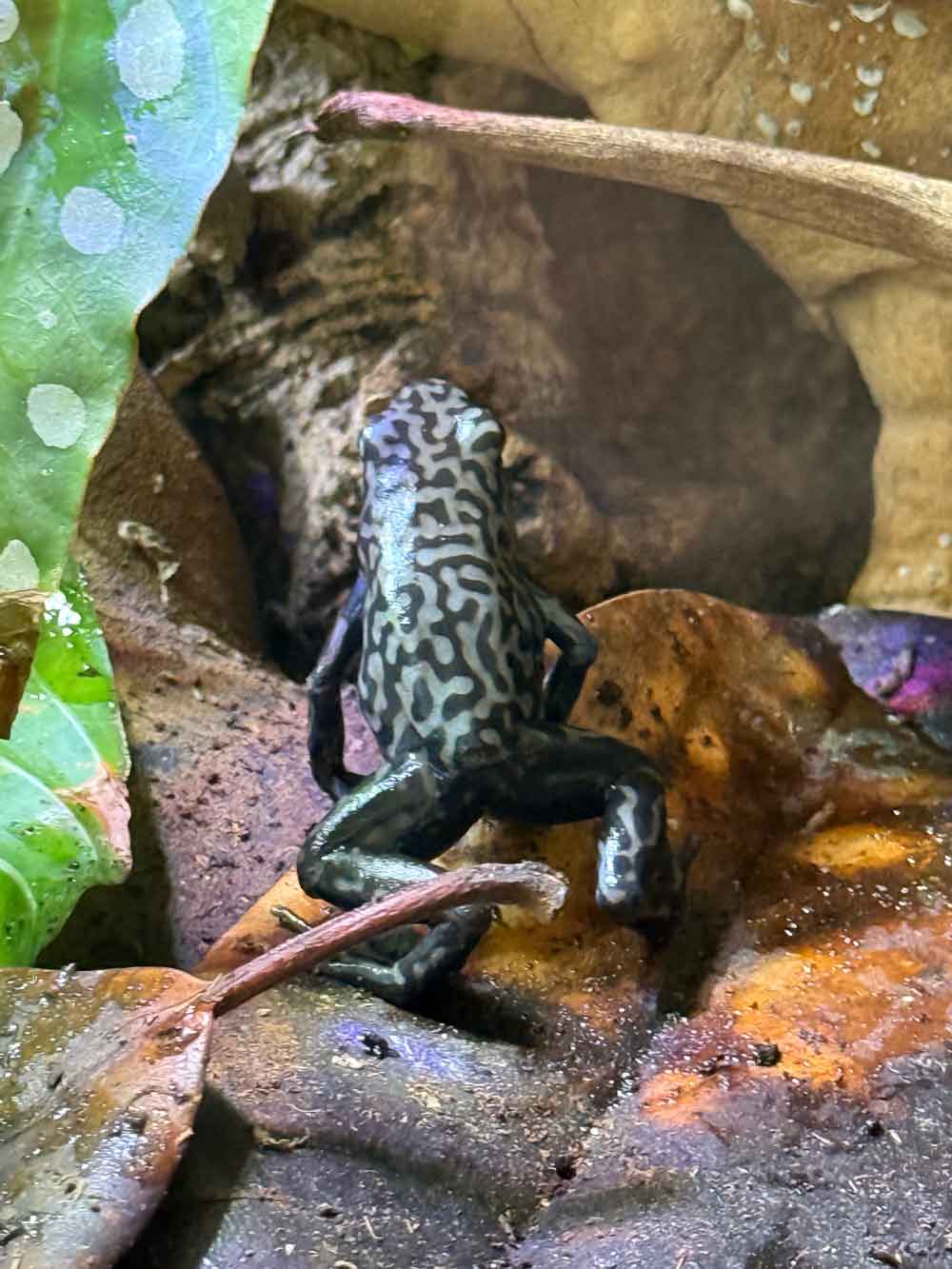
Dendrobates auratus pena blanca. Photo by Carolina Arraujo
With over 100 species across several genera, these amphibians are renowned for their vibrant colors and patterns, which serve as a warning to predators of their toxicity in the wild. Here’s a short list of known genera and notable species of dart frogs:
1. Dendrobates
The genus Dendrobates includes some of the most recognizable and beginner-friendly dart frogs. These frogs are known for their larger size, bold patterns, and relatively straightforward care in captivity.
• Notable Species:
• Dendrobates tinctorius (Dyeing Poison Frog):
Includes many morphs, such as “Aureus” (blue with black spots) and “Patricia” (yellow and black).
• Dendrobates auratus (Green and Black Poison Frog):
Known for green or blue coloration with black marbling.
• Dendrobates leucomelas (Bumblebee Poison Frog):
Distinctive yellow and black stripes; known for its loud calls.
2. Phyllobates
Phyllobates frogs are among the most toxic in the wild. They are slightly larger than other genera and are known for their bold colors and powerful alkaloids.
• Notable Species:
• Phyllobates terribilis (Golden Poison Frog, Blackfoot):
The most toxic frog in the world; commonly found in gold, green, or orange morphs.
• Phyllobates bicolor (Two-Colored Poison Frog):
Bright yellow or orange body with dark limbs.
• Phyllobates vittatus (Golfodulcean Poison Frog):
Black with orange or red stripes running along the body.
3. Ranitomeya
The genus Ranitomeya includes small, highly arboreal frogs known for their intricate patterns and striking colors. They often exhibit parental care, with males transporting tadpoles to water-filled bromeliads.
• Notable Species:
• Ranitomeya ventrimaculata (Amazonian Poison Frog):
Black with yellow markings and a blue belly.
• Ranitomeya fantastica (Fantastic Poison Frog):
Known for its vivid yellow patterns on a black body.
• Ranitomeya reticulata (Reticulated Poison Frog):
Features a net-like black and orange pattern.
• Ranitomeya imitator (Imitation Poison Frog):
Mimics other Ranitomeya species; available in several morphs.
Behavioral Traits of Dart Frogs
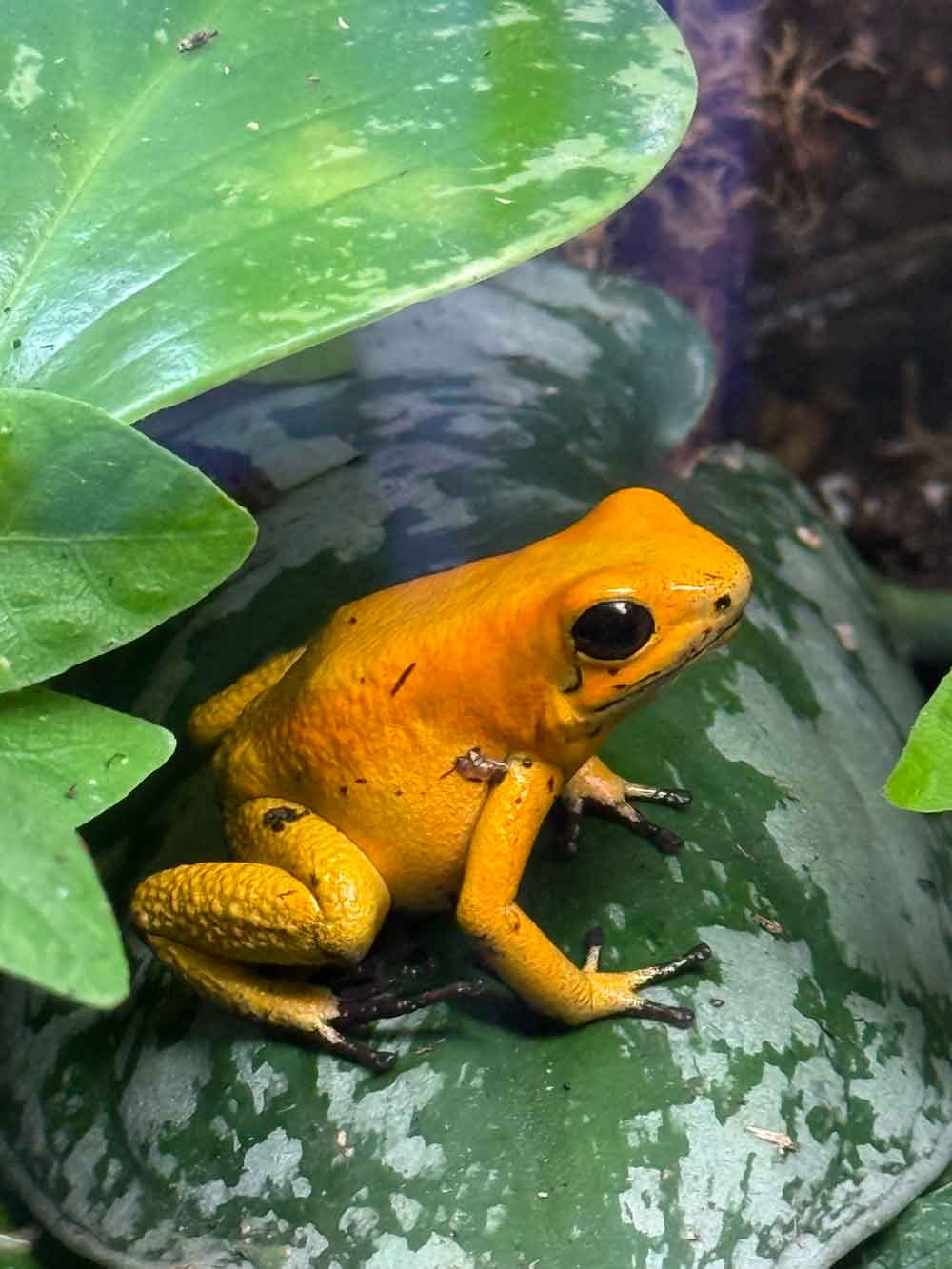
Phyllobates-terribilis. Photo by Carolina Arraujo
Dart frogs are fascinating amphibians, not just for their vibrant colors but also for their unique behaviors. Each genus and species has distinct habits, from their movement patterns to their parenting styles. Here’s an in-depth look at the behaviors that make dart frogs so intriguing:
1. General Activity and Movement
• Diurnal Behavior:
Unlike many amphibians, dart frogs are active during the day, making them excellent display animals. They can often be seen hopping, foraging, and exploring their enclosure.
• Territoriality:
Many dart frog species are territorial, particularly males. They establish and defend small territories through vocalizations or posturing, especially during mating season.
• Climbing and Jumping:
Dart frogs are primarily terrestrial but often climb plants and hardscape in their enclosures. Smaller arboreal species, like Ranitomeya, are more adept climbers.
• Boldness vs. Shyness:
Behavior varies between species and even individuals. Some species, like Dendrodates auratus or Dendrobates tinctorius, are bold and often visible, while others, such as Ranitomeya reticulata, tend to be shy and prefer hiding in foliage.
2. Vocalizations
Dart frogs produce a variety of calls, primarily for communication during mating or territorial disputes.
• Mating Calls:
Male dart frogs emit soft, melodious calls to attract females. Each species has a distinct call, ranging from soft trills (Dendrobates leucomelas) to higher-pitched whistles (Ranitomeya imitator).
• Territorial Calls:
Males may call to warn rivals to stay out of their claimed area. These calls are usually more abrupt and repetitive.
• Volume:
The loudness of the call depends on the species. For example, Phyllobates terribilis has a relatively loud call, while smaller Ranitomeya species produce quieter sounds.
3. Feeding Behavior
• Active Foraging:
Dart frogs are opportunistic hunters. They actively hop around their environment, scanning leaf litter, plants, and hardscape for small prey like fruit flies, springtails, and isopods.
• Precision Hunting:
Their sticky, extendable tongues allow them to capture fast-moving or small prey with remarkable precision.
• Social Feeding:
In group setups, dart frogs often forage together, though competition can arise if food is scarce.
4. Social Interactions
• Group Dynamics:
Dart frogs are generally non-aggressive within species but may show dominance behaviors, especially males. These can include posturing, chasing, or calling to establish hierarchy.
• Compatibility:
Some species, like Dendrobates auratus or Dendrobates leucomelas, can coexist in groups, while others, like Dendrobates tinctorius, are better kept in pairs or individually due to territorial aggression.
• Parental Cooperation:
In species like Ranitomeya imitator or Oophaga pumilio, both parents may play roles in raising offspring, showing a higher degree of social interaction compared to other amphibians.
5. Reproductive Behavior
Dart frogs have fascinating and complex reproductive habits, often involving parental care.
• Courtship Rituals:
Males attract females with calls and displays, often leading them to potential nesting sites like leaf litter, bromeliads, or coconut huts.
• Egg-Laying:
Females lay eggs in moist, protected locations. Males often fertilize the eggs immediately after they are laid.
• Parental Care:
• Egg Moistening: Males or females may return periodically to moisten eggs with their skin secretions.
• Tadpole Transport: Once the eggs hatch, adult frogs (often the male) carry tadpoles on their back to water-filled bromeliads or pools.
• Feeding Tadpoles: In Oophaga species, females feed their tadpoles unfertilized eggs as their sole food source.
6. Defensive Behavior
In the wild, dart frogs rely on their toxicity and aposematic (warning) coloration to deter predators.
• In Captivity:
Captive dart frogs are non-toxic due to their diet, but they retain their instinctual behaviors, such as freezing or fleeing when startled.
• Bold Displays:
Larger species, like Dendrobates tinctorius, may stand their ground and even display dominance behaviors like puffing up their body or hopping toward perceived threats.
7. Microhabitat Preferences
Dart frogs are highly adaptable to their environment but have specific microhabitat preferences depending on the species.
• Terrestrial Species:
Frogs like Dendrobates tinctorius spend most of their time on the forest floor, exploring leaf litter and rocks.
• Arboreal Species:
Species like Ranitomeya ventrimaculata prefer climbing and are often found in bromeliads or on vertical surfaces.
• Semi-Aquatic Behavior:
Some species, like Phyllobates bicolor, may be seen near small water sources but rarely enter them fully.
8. Unique Behaviors by Genera
• Ranitomeya:
Known for intricate parental care, such as males carrying tadpoles to water-filled plants and monitoring their development.
• Oophaga:
Females lay unfertilized eggs to feed their tadpoles, showing highly specialized parenting behavior.
• Phyllobates:
These frogs are bold and often less arboreal, relying on their extreme toxicity for defense in the wild.
9. Seasonal Behaviors
In the wild, dart frog activity is tied to the rainy season, which triggers breeding and increased foraging. In captivity, simulating seasonal changes (e.g., increased misting) can encourage natural behaviors, including mating.
10. Interaction with Humans
• Non-Aggressive Nature:
Dart frogs are not aggressive toward humans and are often indifferent to handling, though they should be observed rather than touched to avoid stress.
• Recognition of Routine:
Some dart frogs learn to associate human presence with feeding and may become more visible and bold over time.
Dart frogs are remarkable not only for their stunning appearance but also for their engaging and complex behaviors. Observing their day-to-day activities offers endless fascination for hobbyists and researchers alike.
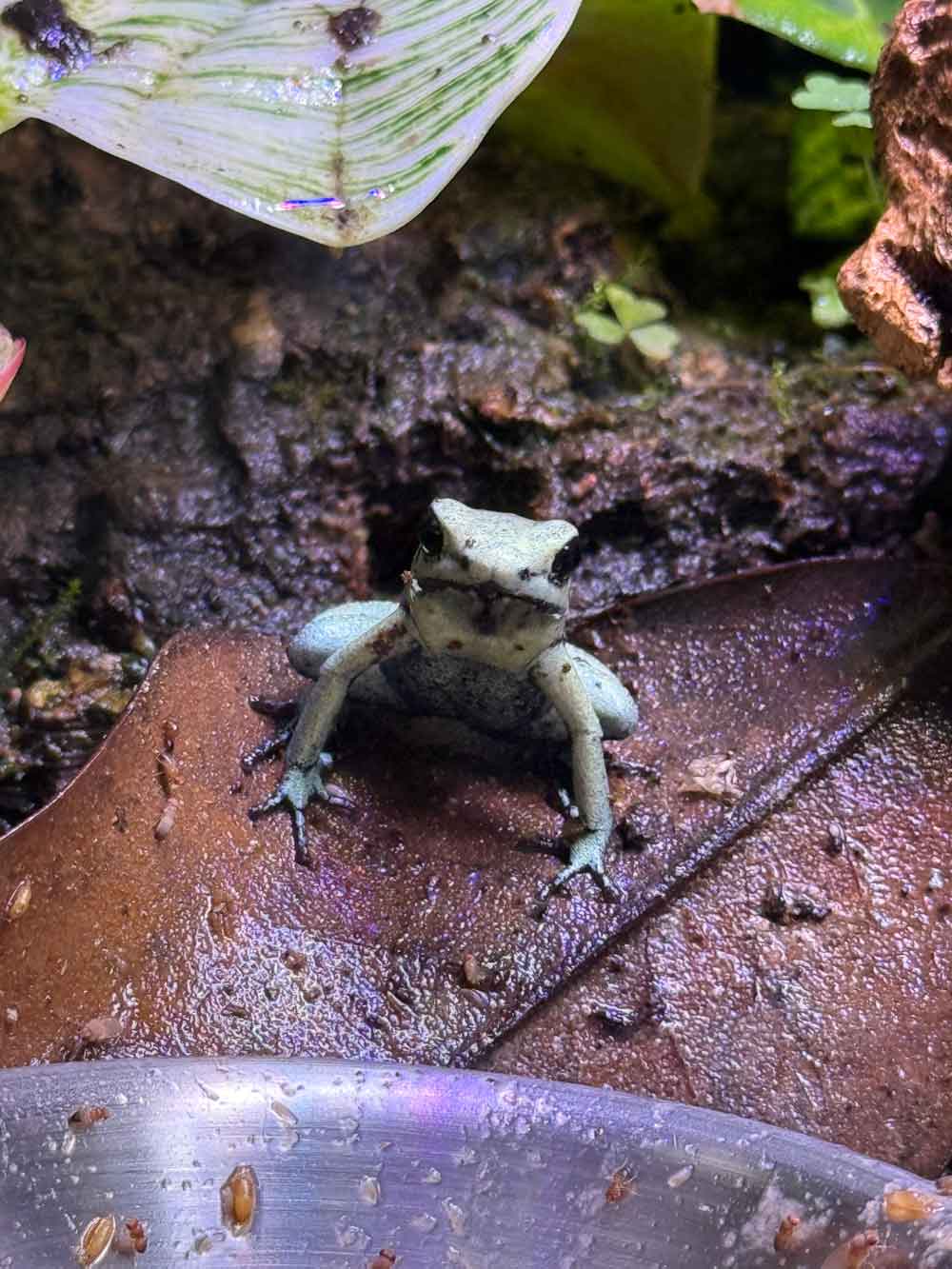
Phyllobates terribilis. Photo by Esmie Lueras
Why the Dart Frog Hobby is So Popular
\The dart frog hobby has grown tremendously in popularity, captivating hobbyists with its unique combination of aesthetics, science, and hands-on care. These small amphibians offer a rewarding experience for enthusiasts of all levels.
Here’s an in-depth look at what makes the dart frog hobby so appealing:
1. Stunning Colors and Patterns
Dart frogs are among the most visually striking animals in the world. Their vibrant hues and intricate patterns, ranging from metallic blues and fiery oranges to speckled greens and yellows, make them living works of art. Each species—and even morphs within the same species—offers a unique palette, allowing hobbyists to curate visually stunning collections. The sheer variety of colors rivals that of tropical fish or exotic birds, making them ideal for display.
2. Unique and Fascinating Behaviors
Dart frogs exhibit captivating behaviors that provide endless entertainment for observers:
• Calling: Males serenade females with their soft, melodic calls.
• Parental Care: The parental dedication shown by species like Oophaga pumilio (e.g., feeding tadpoles unfertilized eggs) is a rare and fascinating trait in amphibians.
• Social Interactions: Their territorial disputes, foraging, and playful movements offer a dynamic glimpse into their natural lives.
These behaviors make dart frogs not just beautiful but deeply engaging animals to keep.
3. Low Maintenance and Accessibility
Once their terrarium is properly set up, dart frogs are relatively low-maintenance compared to many other exotic pets:
• Daily Misting and Feeding: A quick misting and feeding routine suffice for most species.
• No Large Equipment Needs: Unlike reptiles, dart frogs don’t require UVB bulbs, heat lamps, or specialized basking areas.
• Compact Enclosures: Dart frogs thrive in small, well-planted terrariums, making them ideal for people with limited space.
Their manageable care requirements make dart frogs accessible to beginners while still offering challenges and complexities for advanced hobbyists.
4. The Art of Vivarium Design
Dart frog keeping is as much about the habitat as it is about the frogs themselves. Hobbyists can indulge their creativity by crafting beautiful, rainforest-inspired terrariums:
• Bioactive Ecosystems: Setting up a self-sustaining enclosure with live plants, a clean-up crew, and natural substrates creates a miniature ecosystem.
• Living Art: A dart frog terrarium becomes a living work of art, blending vibrant plant life, unique hardscapes, and, of course, the dazzling frogs themselves.
This aspect appeals to nature lovers and design enthusiasts alike.
5. Community and Knowledge Sharing
The dart frog hobby has a thriving, global community that actively shares knowledge, tips, and breeding projects. Social media groups, forums, and reptile expos are filled with hobbyists eager to connect, trade frogs, and exchange ideas. This camaraderie makes it easier for newcomers to get started and fosters long-term engagement with the hobby.
6. Conservation and Education
For many hobbyists, keeping dart frogs goes beyond aesthetics—it’s about contributing to conservation efforts:
• Captive Breeding: Breeding programs help reduce the demand for wild-caught specimens, aiding in the preservation of threatened populations.
• Habitat Appreciation: The hobby raises awareness about the fragility of tropical rainforests and the importance of conservation.
• Educational Value: Observing dart frogs and their ecosystems teaches valuable lessons about biodiversity, symbiosis, and responsible pet keeping.
7. Wide Range of Species and Morphs
The diversity within the dart frog family ensures that there’s a species or morph for every enthusiast:
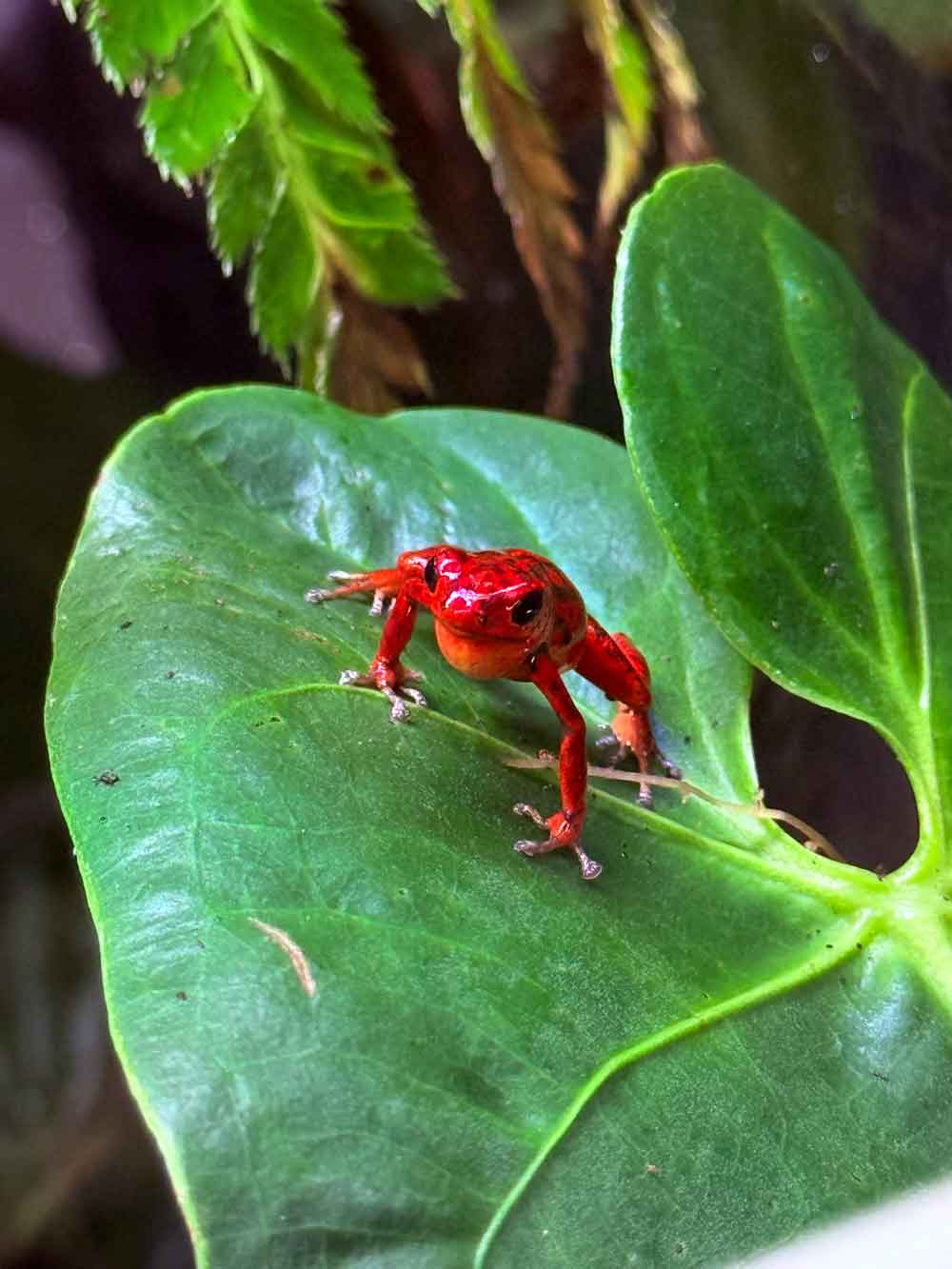
Oophaga vicentei red Photo by Carolina Arraujo
Beginner-Friendly Dart Frogs
These species are hardy, easy to care for, and widely captive bred, making them ideal for newcomers.
Dendrobates Species (Territorial but hardy)
1. Dendrobates tinctorius (Dyeing Poison Frog)
• Morphs: Patricia, Azureus (Blue Dart Frog), Cobalt, Citronella, Green Sipaliwini
• Characteristics: Large, bold, and active; stunning patterns.
• Temperament: Territorial; best in pairs.
2. Dendrobates auratus (Green and Black Poison Frog)
• Morphs: Green and Black, Blue and Black, Bronze
• Characteristics: Smaller and more peaceful; great for groups.
• Temperament: Shy but visible over time.
3. Dendrobates leucomelas (Bumblebee Poison Frog)
• Characteristics: Vibrant yellow and black stripes; loud, melodious calls.
• Temperament: Active and social; can live in groups.
Intermediate Dart Frogs
These species may require more attention to environmental conditions, are smaller or more delicate, or have specialized behaviors.
Phyllobates Species (Larger and Bold)
1. Phyllobates terribilis (Golden Poison Frog)
• Morphs: Yellow, Mint, Orange
• Characteristics: Largest dart frog species; very bold and hardy.
• Temperament: Great for beginners seeking larger frogs, though they need space.
2. Phyllobates bicolor (Two-Colored Poison Frog)
• Characteristics: Bright yellow or orange with darker limbs; easy to care for.
• Temperament: Bold and active; suitable for communal setups.
3. Phyllobates vittatus (Golfodulcean Poison Frog)
• Characteristics: Black with vibrant orange or red stripes.
• Temperament: Hardy but requires good humidity control.
Ranitomeya Species
(Arboreal and Small)
1. Ranitomeya imitator (Imitator Poison Frog)
• Morphs: Varadero, Banded, Chazuta, Tarapoto
• Characteristics: Tiny, vibrant frogs known for intricate parental care.
• Temperament: Best for small, planted enclosures; pairs or trios.
2. Ranitomeya ventrimaculata (Amazonian Poison Frog)
• Characteristics: Black with yellow and blue markings.
• Temperament: Active climbers; small and shy.
3. Ranitomeya fantastica (Fantastic Poison Frog)
• Characteristics: Stunning orange and black patterns; rare morphs.
• Temperament: Requires consistent care; highly rewarding for intermediate keepers.
4. Ranitomeya reticulata (Reticulated Poison Frog)
• Characteristics: Black and orange net-like patterns.
• Temperament: Arboreal and shy; thrives in complex, planted enclosures.
Oophaga Species
(Specialized Care and Parental Behaviors)
1. Oophaga pumilio (Strawberry Poison Frog)
• Morphs: Blue Jeans, Bastimentos, Almirante
• Characteristics: Small, bold, and highly colorful.
• Temperament: Advanced care due to tadpole-feeding needs (unfertilized eggs).
2. Oophaga sylvatica (Diablito Poison Frog)
• Characteristics: Dark and rich color patterns; some morphs are strikingly unique.
• Temperament: Requires larger setups and more advanced care.
Tips for Choosing Dart Frog Species
1. Start with Dendrobates: Their hardy nature and boldness make them perfect for learning the basics of dart frog care.
2. Gradually advance to Ranitomeya or Oophaga: Once you’re confident in maintaining humidity, temperature, and bioactive enclosures, these smaller, more delicate species offer unique behaviors and challenges.
3. Consider Morph Availability: Some morphs, like Ranitomeya varadero or Oophaga pumilio bastimentos, may be harder to find and more expensive.
With proper research and care, transitioning from beginner to intermediate species can open up a captivating world of diversity and beauty within the dart frog hobby!
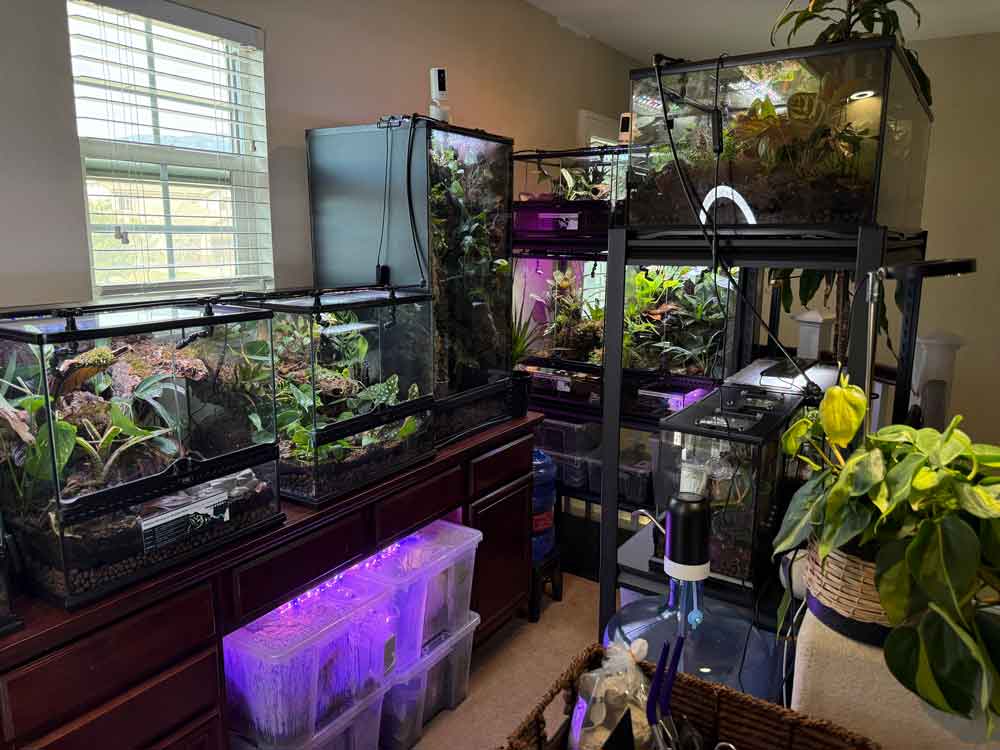
The author’s poison frog room. Photo by Esmie Lueras
In summary
Poison dart frog care is more than a hobby—it’s a gateway to a world of vibrant beauty, fascinating behaviors, and the satisfaction of nurturing a thriving ecosystem. With the right setup, dedication to their needs, and a passion for creating lush, bioactive terrariums, beginners can find immense joy in caring for these captivating amphibians.
For me, this journey started as an unexpected encounter at a reptile expo and has blossomed into a full-fledged passion, transforming my home into a living gallery of tropical art and nature. Whether you’re intrigued by the dazzling colors, the science of creating bioactive habitats, or the thrill of observing these frogs’ unique behaviors, dart frog keeping offers endless opportunities for learning, creativity, and connection.
Life is short, and the joy these tiny rainforest gems bring is worth every moment. If you’re considering joining the dart frog community, don’t hesitate. You’ll gain not just a hobby, but a deep appreciation for the delicate beauty of nature. Follow along with my journey on Instagram (@crazyfrogdivaa) as I continue to learn, share, and celebrate this remarkable world of dart frogs and tropical enclosures!
Esmie Lueras, at the age of 50, became personally obsessed with dart frogs, tropical plants and building their lush enclosures. She found her first pair of Dendrobates tinctorious azureus frogs at a reptile show in Southern California and is now the frog-keeper of 45 dart frogs ranging from Dendrobates, Phyllobatus, Ranitomeya and Oophaga in 15 different vivarium enclosures. Follow her on Instagram under crazyfrogdivaa.
